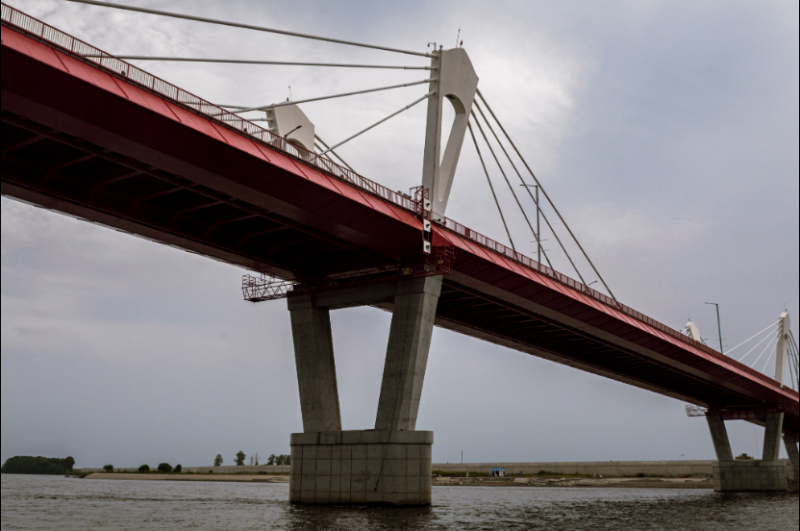
BEIJING: China is rapidly improving transport connections with Russia's Far East, with several recently completed joint infrastructure projects aimed at streamlining trade.
The inaugural voyage of the Quanzhou-Fast East Shipping Line departed in mid-September, and the 2,200-meter Tongjiang-Nizhneleninskoye railway bridge is expected to be inaugurated in the coming months. The Heihe-Blagoveshchensk bridge over the Amur River was opened in June.
Analysts claim that recent Chinese investments in the Far East are aimed at facilitating imports of Russian oil, natural gas and agricultural products. ,
Before Russia's invasion, Beijing and Moscow jointly declared that their friendship had "no boundaries." After that, trade between the two countries has increased significantly.
There are abundant natural resources on the shared border between the two countries, including natural gas, gold, coal, diamonds, timber and seafood. It also serves as a transit hub between Asia and Europe due to the construction of the Trans-Siberian Railway in the late 19th century.
Despite the recent completion of transportation projects, Sergei Ivanov, a senior fellow at the Institute for History, Archeology and Anthropology in the Fast Eastern branch of the Russian Academy of Sciences, claims that large Chinese companies generally shy away from investing in the Far East. ,
"I don't see any structural change in Chinese investment, and the likelihood of [Russia] being under sanctions is even lower," he said. "Over the medium term, we see a decline overall."
According to Li Zhanshu, head of China's top legislative body, trade between China and Russia's Far East, which borders the northeastern province of Heilongjiang, increased 28% year-on-year from last year to about US$14 billion. Gaya, which accounted for about 10%. total bilateral trade
According to Lee, by the end of June, the world's second-largest economy had announced 54 projects in advanced special economic zones and the free port of Vladivostok, worth about $14.7 billion. By comparison, there were US$2.4 billion in 2019.
Also Read: US Department of Defense banned DJI and BGI Genomicsin because of their ties with Chinese military
Russia's Deputy Prime Minister Yuri Trutnev said China took more than 90% of all foreign investment into the Far East ahead of the Eastern Economic Forum in September.
Chinese media claimed that China invested 85% in the sector in 2020, while Russian officials claimed it was 71% in 2016-17.
However, analysts say the increasing share of Chinese foreign investment may not be due to increased capital inflows, especially as foreign investors withdraw from Russia following the invasion of Ukraine.
Japan and South Korea, two important Far Eastern consumers, were designated as "unfriendly countries" by Moscow in March.
Ivanov claimed that Russia's "pivot to the east" strategy, announced by Russian President Vladimir Putin in 2012, was not intended to draw in foreign capital, but to consolidate regional assets held by major Russian corporations.
"The simple question of whether Russian big business will be willing to share assets will inevitably come up against any expansion of Chinese investment in the Far East," he said.
Beyond the energy industry, Russia wants to increase trade with China, focusing on agricultural products.
One business with investment plans in the area is Jiabei Agricultural Holding Company, which has 3,100 hectares (7,660 acres) of agricultural land in the Far East. It has said it will spend 400 million yuan, or $56.2 million, on infrastructure upgrades, asset acquisitions and grain dock construction between 2022 and 25.
A road map for bilateral cooperation in the Far East identified agriculture as one of the key investment sectors in 2018.
The manager of a Chinese agricultural firm operating in the Far East claimed that the impact of the coronavirus pandemic on the conflict and crop farming sector in Ukraine is relatively small and that business will continue as usual.
The geopolitical unrest, the person who wished to remain anonymous, added, "[but] there is a greater risk facing investors in the future, as exchange rate volatility will have a huge impact on business operations."
"We will neither attack nor run away,"
According to official data, total Chinese investment in Russia has been steadily declining over the years, falling from US$2.96 billion in 2015 to US$570 million in 2020. There are no figures available for 2021.
According to Anton Kiriev, an associate professor at the Far Eastern Federal University, the structure of Chinese investment favored an economic model based on the extraction and export of natural resources.
He stated in the August issue of World Economy and International Relations that "the volume of accumulated Chinese capital is not sufficient to replace the reduced budgetary investments in the region."